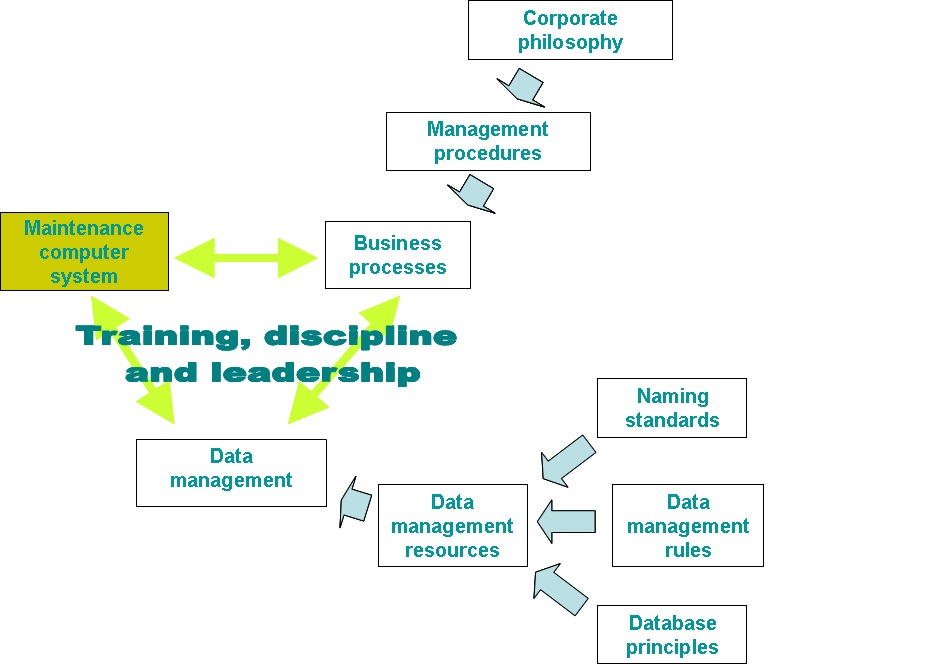This article is Part 1 of five parts about maintenance computer systems (or “CMMS”, for Computerized Maintenance Management Systems, an abbreviation I avoid because many people don’t know what it stands for).
The five parts to this article are:
Part 1 – Overview of the purpose of a maintenance computer system
Part 2 – Business processes and data management
Part 3 – The maintenance computer system project
Part 4 – System selection
Part 5 – Improving existing systems
These articles cover a lot more than just systems because on their own, maintenance computer systems are worth nothing. They are just a tool to use to store and process the information which is essential for managing maintenance activities and which is generated as a result of those activities. Like any other tool, they must be used properly to do the job they are supposed to do, and they are just one component of the total maintenance information-management process.
It has been reported that 50 to 70% of maintenance computer systems fail. If “failure” means that they do not improve maintenance performance, compared to the performance prior to their implementation, sufficiently to justify their initial and ongoing cost, then even the 70% figure may be on the low side. My opinion is that the best test of success is to ask supervisors and tradespeople, especially those on shift, how the system has helped them to do their jobs.
Maintenance computer systems have three primary purposes:
- To assist maintenance people, at all levels, to provide excellent service to their organization,
- To provide detailed maintenance cost information to the organization’s financial system and
- To provide all system users and their customers with up-to-date information on maintenance work.
Unfortunately, many systems do a good job of collecting cost information but a poor job of managing maintenance activities and often a poor job of sharing maintenance work information. These problems may result from inadequate system functionality, poorly-managed implementation or both.
Maintenance computer systems serve a wide range of users, from frequent and expert users such as Planners, Supervisors and engineers, to infrequent and unfamiliar users who may use the system only to request repair work or to find supplies in the Storeroom. They must have the functionality to manage complex maintenance activities yet be simple enough for anyone to perform basic functions, such as requesting work and tracking their requests (See “Make your maintenance software user-friendly“)
First and foremost, any maintenance computer system MUST help Maintenance people to do their jobs by improving the way that work is selected, prioritized and scheduled, and by helping to get the right people, tools, materials, equipment, information and instructions to the right place at the right time. It must also record and process the information resulting from maintenance activity so that it will be used to improve maintenance performance, and securely store all information on equipment, spare parts and other assets.
The system must also record maintenance costs at the appropriate level and in the format required by the organization’s financial system. If the system is a useful maintenance-management tool, it will be consistently used and this will result in accurate cost records. If it is perceived as an unhelpful cost-recording system it is likely that practices such as the use of standing work orders, charging work orders to high levels in the equipment hierarchy and using “any old open work order” for small jobs will evolve. The result is that the financial system, even though it may produce impressive reports, will do so based on very “dirty” source data.
The system should also produce Key Performance Indicator (KPI) reports, especially of lagging KPI’s such as reliability, which requires that the database also includes reliability information (see “Measuring Maintenance Performance – the hazards of KPI’s” ). This is a feature that is lacking in many systems.
In non-industrial institutions (universities, schools, etc) the most common complaint about Maintenance is that whenever work is requested there is no follow up to keep the requestor informed of its status. The system should have the functionality to make this information always available to anyone who is interested.
Maintenance management is mostly about managing information, and to do that effectively the maintenance management computer system must be part of a complete information system, as in the picture below.

The maintenance computer system is just one corner of the triangle. The other two corners (business processes and data management) are more important. With them both in place, maintenance can be well-managed, even without a maintenance computer system.
To look at these in a little more detail go to Part 2 .
© Veleda Services Ltd
Don Armstrong, President
don.armstrong@veleda.ca
250-655-8267 Pacific Time